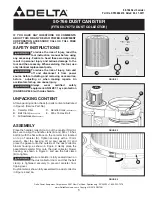
RF Baghouse, Models RFT, RFW, and RFWH
26
Turn positive displacement pump OFF and bleed
lines and tank before performing service or
maintenance work.
Operational Checklist
1. Monitor the physical condition of the collector and
repair or replace any damaged components.
Routine inspections will minimize downtime and
maintain optimum system performance. This
is particularly important on continuous-duty
applications.
2. Periodically check the positive displacement pump
components and replace filters as required to
maintain blower pressure rating. Check rotation of
cleaning arms.
3. Monitor pressure drop across filters.
Abnormal changes in pressure drop may indicate a
change in operating conditions and possibly a fault
to be corrected.
4. Monitor exhaust.
5. Monitor dust disposal.
Quarterly
1. Check condition of the clean-air plenum. If dust
accumulation is present, check filter bags for wear,
tears or loose seals. Replace as necessary.
2. On high inlet collectors, check the condition of the
removable baffle weld assembly by removing the
side access cover on the baffle housing. Replace
significantly worn baffle assemblies to prevent
damage to the filter tubes and housing section.
3. Check solenoid and diaphragm valve operation.
4. Check door seals and replace as necessary.
5. Check cleaning arm drive chain and positive-
displacement blower belt tension.
6. Check positive-displacement blower and gear
reducer oil levels. Add oil through breather mounting
holes or other oil fill locations. Reference the blower
owner’s manual for proper lubricant.
0°F-32°F - use ISO 68 lubricant
32°F-90°F - use ISO 100 lubricant
90°F-120°F - use ISO 150 lubricant
7. Inspect explosion vents, if applicable, for signs of
wear or cracks.
8. Check the rotating arm manifold drive gear reducer
oil level. Add oil through breather mounting holes or
other oil fill locations. The gear reducer is filled with
synthetic oil. See reducer manual for recommended
lubrication type and quantity. When checking or
replacing the oil, make sure to check both housings
of the double reduction reducer. Each housing has
its own vent, fill and drain plug.
Weekly
1. Check that pressure drop is within normal
operational range (from 1 to 6 "wg).
2. Check for proper air pressure at reservoir (7.5-psig).
3. Check for proper lubricant level in positive-
displacement blower. Reference the positive
displacement blower owner’s manual.
4. Check positive displacement blower inlet air filter to
see how dirty it is. Clean blower intake filter by using
a commercial cleaner such as Oakite and water. Dry
thoroughly and immerse in SAE 30 engine oil. Drain
off excess oil and reassemble. Do not use gasoline to
clean blower intake filter due to possible explosion.
Instruct all personnel on safe use and maintenance
procedures.
Use proper equipment and adopt
all safety precautions needed for
servicing equipment.
Use appropriate access equipment and
procedures. Note the standard collector is not
equipped with access platforms unless noted
on the specification drawings.
Electrical service or maintenance work must
be performed by a qualified electrician and
comply with all applicable national and local
codes.
Turn power off and lock out all power before
performing service or maintenance work.
Do not install in classified hazardous
atmospheres without an enclosure rated for
the application.
Maintenance Information



































